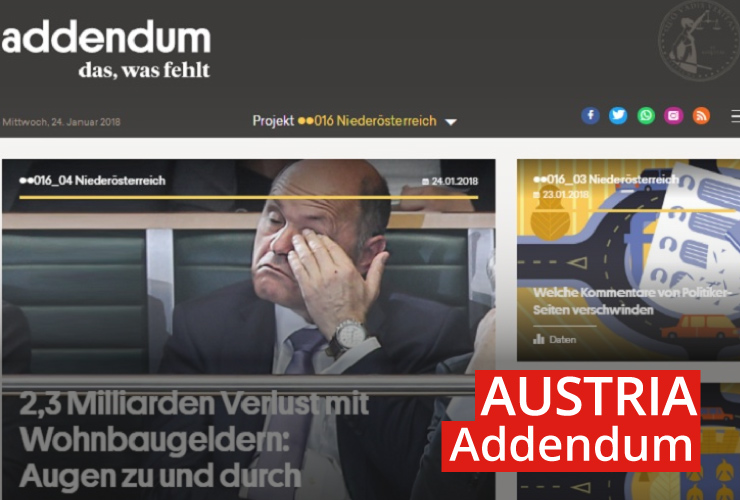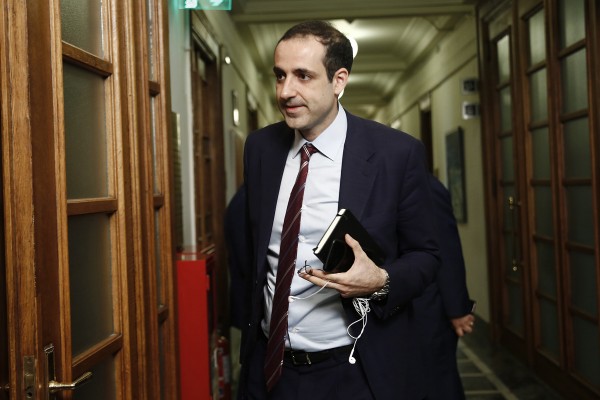With many traditional media facing difficult financial challenges, the task of tackling misinformation and “fake news” has increasingly fallen to independent fact-checking initiatives and start-ups.
In Austria, a new initiative called Addendum has thrown its hat into the ring.
Addendum, which produces a television feature (“In Context” on the private broadcaster ServusTV) as well as detailed articles on various topics such as immigration, the state, finance and democracy, is published by Quo Vadis Veritas Redaktions (QVV) GmbH, which in turn was founded by the non-profit Quo Vadis Veritas Foundation.
“The main issue was that there is a crisis in the media,” Niko Alm, managing director of Addendum, told IPI. “The crisis is mainly due to non-working business models, so the traditional media has problems funding itself.”
Alm said that there were fewer and fewer resources to fund investigative journalism, with a lot of the readers and advertising revenues moving to intermediaries like Google and Facebook.
“Consequently, traditional media have shifted more towards opinion in order to reach audiences,” he suggested.
“We think there is more room for current, in-depth, researched journalism to contribute more facts and data in support of ongoing debates.”
Meeting a need
Alm noted that Addendum was in a very fortunate position given that QVV was set up by the Salzburg, Austria-based company Red Bull. Any financial loss Addendum makes would be covered by the foundation.
He emphasised that Addendum did not see itself as a competitor to other Austrian media outlets: “Others are free to draw from our work. I hope that more media want us as partners – to exploit us, basically.”
Addendum employs some 50 people, around 30 of them journalists. They work in teams and, depending on the topic, collaborate with outside experts, statisticians, finance experts and university researchers, among others.
Alm said he believed Addendum’s content answered a real need even amid changing media consumption habits.
“People like well-researched pieces; the demand is obviously there,” he told IPI. “But they also want stuff in an easily digestible format. They have to consume more and more information, and it is often difficult to summarise a large number of researched facts.”
According to Alm, Addendum reaches approximately 200,000 people a month, with some 20,000 active monthly users. He said that good articles gained a reach comparable to that of large Austrian media houses, a satisfactory result given that Addendum’s website has only been in operation since the autumn of 2017.
Bringing back facts
In Alm’s view, the financial difficulties faced by fact-based journalism have allowed disinformation to thrive.
“We’ve always had rumours and false information, but this is new,” he said. “The fake news phenomenon combines all sorts [of false content] and spreads it through networks and social media. Ordinary people can spread it very efficiently.”
Moreover, Alm said that with all kinds of alternative content mushrooming, many readers and viewers had diverted away from traditional media. Media outlets were working to respond to the drop, but not always in the best way.
“I even see it in my favourite newspapers and magazines. I detect more opinion and unnecessary bias that I didn’t see before. They are trying to distinguish themselves. Biased might be the wrong word, but it’s not just plain news.”
Originally, Addendum was described as a platform that would work to debunk “fake news”. But Alm said that Addendum was not interested “in cleaning up the mess in that way”.
“You can dismantle and debunk fake news of course, as many other outlets do,” he said. “But we have another approach. We try to provide solid data and facts for others to use. You need both approaches. You need to point out what is false, but you also need to provide the facts and data so that there is a trustworthy market for evidence-based journalism.”
RELATED ARTICLE: In Austria, debate over ‘fake news’ lays bare societal polarisation
ABOUT THIS SERIES: IPI’s reporting project Contending with “Fake News” examines the particular dynamic around the “fake news” debate in five EU countries, offering a look a the sources, styles and goals of disinformation in each country as well as the extent to which that debate has affected public discourse, politics and press freedom. The series also profiles five initiatives that have adopted innovative solutions to addressing disinformation and building trust in fact-based journalism and that could potentially serve as models for similar efforts elsewhere. Read more.



